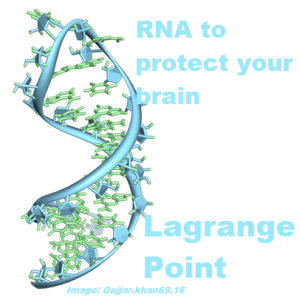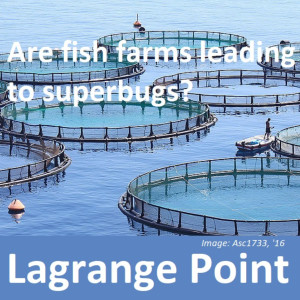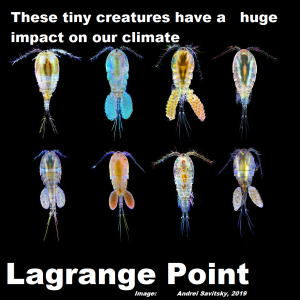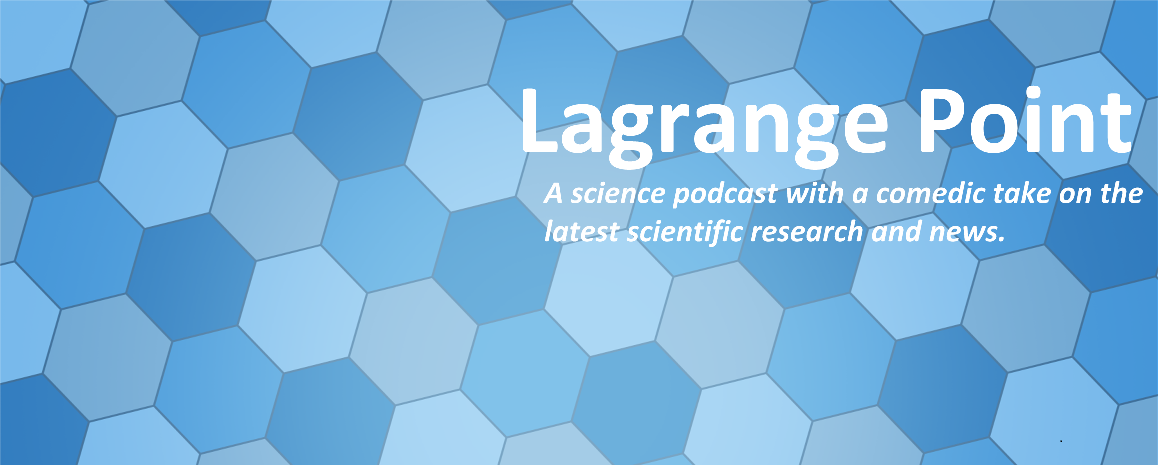Episodes

Monday Nov 01, 2021
Episode 455 - Growing rocket fuel on Mars and greener jet fuel on earth
Monday Nov 01, 2021
Monday Nov 01, 2021
Growing rocket fuel on the surface of Mars, and greener jet fuel here on earth. The problem with space travel is you have to take everything with you. Including fuel. Is there a way to grow your own fuel to make the load lighter on a rocket? A round trip to Mars needs billions of dollars of fuel. Is there a way we can reduce cost and energy by producing rocket fuel on the surface of Mars? How can you grow rocket fuel on mars using microbes? Would the same rocket fuel you use on Earth make sense to use on Mars? How can we clean up the aviation industry's carbon emissions? Are there alternative jet fuels that don't come at the expense of growing food? Bio-fuels are often produced at the expense of food, but are there alternatives that are win win?
References:
- Nicholas S. Kruyer, Matthew J. Realff, Wenting Sun, Caroline L. Genzale, Pamela Peralta-Yahya. Designing the bioproduction of Martian rocket propellant via a biotechnology-enabled in situ resource utilization strategy. Nature Communications, 2021; 12 (1) DOI: 10.1038/s41467-021-26393-7
- Asiful Alam, Md Farhad Hossain Masum, Puneet Dwivedi. Break-even price and carbon emissions of carinata-based sustainable aviation fuel production in the Southeastern United States. GCB Bioenergy, 2021 DOI: 10.1111/.1gcbb2888

Monday Oct 25, 2021
Episode 454 - Evolution‘s strange journeys in crabs, snakes and lizards
Monday Oct 25, 2021
Monday Oct 25, 2021
Why does nature continually evolve crabs? What is so good about crabs that nature just cannot stop inventing it? How can you trap a crab inside amber? What can a fossilized crab, capture din amber tell us about the complex history of crabs? Just when did crabs invade land and how did they get stuck in tree sap? How do you preserve fossil as delicate as a crab? How did lizards and snakes develop their complex teeth? Mammals weren't the only ones to evolve complex teeth with cusps. Evolution isn't necessarily a one way progression, sometimes complexity can be rolled back like in lizards. Lizards developed complex teeth to eat plants, but then some went back to their old ways.
References:
- Keiler, J., Wirkner, C., & Richter, S. (2017). One hundred years of carcinization – the evolution of the crab-like habitus in Anomura (Arthropoda: Crustacea). Biological Journal Of The Linnean Society, 121(1), 200-222. doi: 10.1093/biolinnean/blw031
- Watson, S. (2021). Why everything eventually becomes a crab. Retrieved 23 October 2021, from https://www.popsci.com/story/animals/why-everything-becomes-crab-meme-carcinization/
- Fabien Lafuma, Ian J. Corfe, Julien Clavel, Nicolas Di-Po�. Multiple evolutionary origins and losses of tooth complexity in squamates. Nature Communications, 2021; 12 (1) DOI: 10.1038/s41467-021-26285-w

Monday Oct 11, 2021
Episode 452 - Eureka Prizes 21 - Fighting back against viruses
Monday Oct 11, 2021
Monday Oct 11, 2021
We celebrate the winners of the Eureka Prizes in 2021. The top prizes in Aussie Science shows that it's possible for major science awards to not be male dominated. Are humans just the collateral damage of the war between cholera and protozoa? How does getting eaten actually make cholera stronger? We celebrate the achievements of Australian scientists helping make rotavirus vaccines more accessible for all. Producing vaccines cheaply and locally, that are easy to roll out can save half a million lives each year. Whilst vaccines for rotavirus exist already they are complex and costly. Aussie researchers are helping make it simpler and widely available.
References:
- Gustavo Espinoza-Vergara, Parisa Noorian, Cecilia A. Silva-Valenzuela, Benjamin B. A. Raymond, Christopher Allen, M. Mozammel Hoque, Shuyang Sun, Michael S. Johnson, Mathieu Pernice, Staffan Kjelleberg, Steven P. Djordjevic, Maurizio Labbate, Andrew Camilli, Diane McDougald. Vibrio cholerae residing in food vacuoles expelled by protozoa are more infectious in vivo. Nature Microbiology, 2019; DOI: 10.1038/s41564-019-0563-x
- Bines, J., At Thobari, J., Satria, C., Handley, A., Watts, E., & Cowley, D. et al. (2018). Human Neonatal Rotavirus Vaccine (RV3-BB) to Target Rotavirus from Birth. New England Journal Of Medicine, 378(8), 719-730. doi: 10.1056/nejmoa1706804
- Mannix, L. (2021). Eureka science prizes go to childhood vaccine and microplastics hotspot hunt. Retrieved 9 October 2021, from https://www.smh.com.au/national/childhood-vaccine-microplastics-hotspot-hunt-take-top-science-gongs-20211007-p58xyi.html
- Protozoans and pathogens make for an infectious mix. (2021). Retrieved 9 October 2021, from https://www.uts.edu.au/news/health-science/protozoans-and-pathogens-make-infectious-mix
- Tu, J. (2021). Meet the women transforming science in Australia: Eureka Prize finalists. Retrieved 9 October 2021, from https://womensagenda.com.au/latest/meet-the-women-transforming-science-in-australia-eureka-prize-finalists/

Monday Oct 11, 2021
Episode 452 - Eureka Prizes 21 - Fighting back against viruses
Monday Oct 11, 2021
Monday Oct 11, 2021
We celebrate the winners of the Eureka Prizes in 2021. The top prizes in Aussie Science shows that it's possible for major science awards to not be male dominated. Are humans just the collateral damage of the war between cholera and protozoa? How does getting eaten actually make cholera stronger? We celebrate the achievements of Australian scientists helping make rotavirus vaccines more accessible for all. Producing vaccines cheaply and locally, that are easy to roll out can save half a million lives each year. Whilst vaccines for rotavirus exist already they are complex and costly. Aussie researchers are helping make it simpler and widely available.
References:
- Gustavo Espinoza-Vergara, Parisa Noorian, Cecilia A. Silva-Valenzuela, Benjamin B. A. Raymond, Christopher Allen, M. Mozammel Hoque, Shuyang Sun, Michael S. Johnson, Mathieu Pernice, Staffan Kjelleberg, Steven P. Djordjevic, Maurizio Labbate, Andrew Camilli, Diane McDougald. Vibrio cholerae residing in food vacuoles expelled by protozoa are more infectious in vivo. Nature Microbiology, 2019; DOI: 10.1038/s41564-019-0563-x
- Bines, J., At Thobari, J., Satria, C., Handley, A., Watts, E., & Cowley, D. et al. (2018). Human Neonatal Rotavirus Vaccine (RV3-BB) to Target Rotavirus from Birth. New England Journal Of Medicine, 378(8), 719-730. doi: 10.1056/nejmoa1706804
- Mannix, L. (2021). Eureka science prizes go to childhood vaccine and microplastics hotspot hunt. Retrieved 9 October 2021, from https://www.smh.com.au/national/childhood-vaccine-microplastics-hotspot-hunt-take-top-science-gongs-20211007-p58xyi.html
- Protozoans and pathogens make for an infectious mix. (2021). Retrieved 9 October 2021, from https://www.uts.edu.au/news/health-science/protozoans-and-pathogens-make-infectious-mix
- Tu, J. (2021). Meet the women transforming science in Australia: Eureka Prize finalists. Retrieved 9 October 2021, from https://womensagenda.com.au/latest/meet-the-women-transforming-science-in-australia-eureka-prize-finalists/

Monday Sep 27, 2021
Episode 450 - Dating lobsters and islands under the sea
Monday Sep 27, 2021
Monday Sep 27, 2021
Dating lobsters can be tricky and not just because they pinch. We think lobsters can live for decades or centuries, but we can't actually track their age. Just how do you find out a creatures age without dissecting them? Tracking a creatures age is tricky when they cast away alot of signs of physical growth. How can there tightly knit families spread across huge distances in the sea that are somehow connected? How do genetic islands form inside the oceans? What can chaos, larvae and Antarctica tell us about genetic diversity?
- Eleanor A. Fairfield, David S. Richardson, Carly L. Daniels, Christopher L. Butler, Ewen Bell, Martin I. Taylor. Ageing European lobsters ( Homarus gammarus ) using DNA methylation of evolutionarily conserved ribosomal DNA. Evolutionary Applications, 2021; DOI: 10.1111/eva.13296
- David L. J. Vendrami, Lloyd S. Peck, Melody S. Clark, Bjarki Eldon, Michael Meredith, Joseph I. Hoffman. Sweepstake reproductive success and collective dispersal produce chaotic genetic patchiness in a broadcast spawner. Science Advances, 2021; 7 (37) DOI: 10.1126/sciadv.abj4713

Monday Aug 30, 2021
Episode 446 - Brains and Guts connected in surprising ways
Monday Aug 30, 2021
Monday Aug 30, 2021
Your brain and gut are connected in surprising ways. Inside your GI tract is a surprisingly complex nervous system. Your GI tract has it's own nervous system which is more like the spine than other organs. How does your GI tract differ from other soft hollow organs? The connection between gut microbiomes and brains is clear, but not well understood. Certain microbes can cause neurodegeneration in brains just as bad as a poor diet and no oxygen. How can we stop brains copy and pasting toxic byproducts across our brains? Proteins keep our brains in check and prevent build up of toxic byproducts, but this can be used to put the brakes on neurodegeneration.
References:
- Nick J. Spencer, Lee Travis, Lukasz Wiklendt, Marcello Costa, Timothy J. Hibberd, Simon J. Brookes, Phil Dinning, Hongzhen Hu, David A. Wattchow, Julian Sorensen. Long range synchronization within the enteric nervous system underlies propulsion along the large intestine in mice. Communications Biology, 2021; 4 (1) DOI: 10.1038/s42003-021-02485-4
- Christine A. Olson, Alonso J. Iñiguez, Grace E. Yang, Ping Fang, Geoffrey N. Pronovost, Kelly G. Jameson, Tomiko K. Rendon, Jorge Paramo, Jacob T. Barlow, Rustem F. Ismagilov, Elaine Y. Hsiao. Alterations in the gut microbiota contribute to cognitive impairment induced by the ketogenic diet and hypoxia. Cell Host & Microbe, 2021; DOI: 10.1016/j.chom.2021.07.004
- Chingakham Ranjit Singh, M. Rebecca Glineburg, Chelsea Moore, Naoki Tani, Rahul Jaiswal, Ye Zou, Eric Aube, Sarah Gillaspie, Mackenzie Thornton, Ariana Cecil, Madelyn Hilgers, Azuma Takasu, Izumi Asano, Masayo Asano, Carlos R. Escalante, Akira Nakamura, Peter K. Todd, Katsura Asano. Human oncoprotein 5MP suppresses general and repeat-associated non-AUG translation via eIF3 by a common mechanism. Cell Reports, 2021; 36 (2): 109376 DOI: 10.1016/j.celrep.2021.109376

Monday Aug 16, 2021
Episode 444 - Deadly Creatures in Australia for Nat. Sci Week
Monday Aug 16, 2021
Monday Aug 16, 2021
It's National Science Week in Australia so we celebrate with some Aussie Science. What's more Aussie than dangerous creatures? Queensland Museum researchers have found even more spiders in Brisbane. Golden Trapdoors sound like they contain treasure, but since it's Australia we're talking about, its just another scary creature. Your average Brisbane backyard may contain more types of spiders than you imagine. How did snakes evolve their deadly fangs? What came first the venom or the tooth? Why have so many different snakes evolved venom where Lizards haven't? In Australia even the plants can be deadly. We know tobaccos is dangerous, but in WA scientists have found an insect eating wild tobacco plant. Wild tobacco plants can thrive in odd places in Australia and can even chow down on Insects.
- Wilson, J. D., & Rix, M. G. (2021). Systematics of the AUSTRALIAN golden trapdoor spiders of the EUOPLOS VARIABILIS-GROUP (Mygalomorphae : IDIOPIDAE : Euoplini): Parapatry And Sympatry between closely related species in SUBTROPICAL QUEENSLAND. Invertebrate Systematics. https://doi.org/10.1071/is20055
- Chase, M. W., & Christenhusz, M. J. (2021). 994. NICOTIANA INSECTICIDA: Solanaceae. Curtis's Botanical Magazine. https://doi.org/10.1111/curt.12402
- Palci, A., LeBlanc, A., Panagiotopoulou, O., Cleuren, S., Mehari Abraha, H., Hutchinson, M., Evans, A., Caldwell, M. and Lee, M., 2021. Plicidentine and the repeated origins of snake venom fangs. Proceedings of the Royal Society B: Biological Sciences, 288(1956), p.20211391.

Monday Aug 09, 2021
Episode 443 - Strange chemistry, ice, life and moons
Monday Aug 09, 2021
Monday Aug 09, 2021
Moons across our solar system have rich chemistry that may harbor life. Ganymede may have more water in it's 'oceans' than Earth. The makeup of Ganymede may include layers of ice, oceans and even water vapor atmospheres. Piecing together data from Hubble, Galileo and Juno to help crack the mystery of Ganymede's atmosphere. Melting ice on Ganymede's surface could explain the odd atmosphere. Enceladus has great geysers but they contain more methane than we can explain...unless we consider biological systems. Enceladus has many mysteries beneath it's ice, but could geothermal vents help explain whats in it's geysers? Cassini did a daring flyby through Enceladus' geysers, but they were filled with many things we did not expect.
- Lorenz Roth, Nickolay Ivchenko, G. Randall Gladstone, Joachim Saur, Denis Grodent, Bertrand Bonfond, Philippa M. Molyneux, Kurt D. Retherford. A sublimated water atmosphere on Ganymede detected from Hubble Space Telescope observations. Nature Astronomy, 2021; DOI: 10.1038/s41550-021-01426-9
- Antonin Affholder, François Guyot, Boris Sauterey, Régis Ferrière, Stéphane Mazevet. Bayesian analysis of Enceladus’s plume data to assess methanogenesis. Nature Astronomy, 2021; DOI: 10.1038/s41550-021-01372-6

Monday Jul 26, 2021
Episode 441 - Augmenting the human body to keep it safe
Monday Jul 26, 2021
Monday Jul 26, 2021
Using technology and tools to make the human body safer. How can we use exoskeletons to keep people safe? Does using a tool like an exoskeleton automatically make a task easier? How can technology that augments bodys hinder when trying to help? How can we keep our head safer during a collision. Countless people rely on bicycles for safe and green transport, but how do we make it safer? Bicycle helmets are a simple tool for helping save lives, but can they be made even safer with new materials?
- Yibo Zhu, Eric B. Weston, Ranjana K. Mehta, William S. Marras. Neural and biomechanical tradeoffs associated with human-exoskeleton interactions. Applied Ergonomics, 2021; 96: 103494 DOI: 10.1016/j.apergo.2021.103494
- Karl A Zimmerman, Etienne Laverse, Ravjeet Samra, Maria Yanez Lopez, Amy E Jolly, Niall J Bourke, Neil S N Graham, Maneesh C Patel, John Hardy, Simon Kemp, Huw R Morris, David J Sharp. White matter abnormalities in active elite adult rugby players. Brain Communications, 2021; 3 (3) DOI: 10.1093/braincomms/fcab133

Monday Jul 19, 2021
Episode 440 - Turning off plants with a switch of a light
Monday Jul 19, 2021
Monday Jul 19, 2021
Turning off plants with a switch of a light. How can optogenetics be used to turn off photosynthesis. Stomata cells help a plant from feasting too much in times of famine. Stomata cells regulate how much photosynthesis plants undertake, but can they be regulated with light? How can Yeast be used to help plants fight back against fungus. Fungal infections can devastate crops and plants, but can we avoid dangerous fungicides? How can we protect plants from, fungi without damaging the environment? Can yeast grown proteins help stop fungal infections without killing all fungi?
- Tiffany Chiu, Anita Behari, Justin W. Chartron, Alexander Putman, Yanran Li. Exploring the potential of engineering polygalacturonase‐inhibiting protein as an ecological, friendly, and nontoxic pest control agent. Biotechnology and Bioengineering, 2021; DOI: 10.1002/bit.27845
- Shouguang Huang, Meiqi Ding, M. Rob G. Roelfsema, Ingo Dreyer, Sönke Scherzer, Khaled A. S. Al-Rasheid, Shiqiang Gao, Georg Nagel, Rainer Hedrich, Kai R. Konrad. Optogenetic control of the guard cell membrane potential and stomatal movement by the light-gated anion channel GtACR1. Science Advances, 2021; 7 (28): eabg4619 DOI: 10.1126/sciadv.abg4619

Monday Jul 12, 2021
Episode 439 - The journey of humanity and its closet cousins
Monday Jul 12, 2021
Monday Jul 12, 2021
What separates Homo Sapiens from our closest cousins? How do we piece together the journey of Homo Sapiens across the world? Neanderthals were capable of much more than what stereotypes suggest. How did Neanderthals produce complex art? How did Neanderthals and Homo Sapiens intermix? Was there a linking population that helped spread Homo Sapiens genes into Neanderthals long before mass migration? Neanderthals are often thought of as Europe based, but was there a larger progenitor population in the Levant?
- Mooallem, J. (2021). The Sunday Read: ‘Neanderthals Were People, Too’. Retrieved 11 July 2021, from https://www.nytimes.com/2021/05/23/podcasts/the-daily/neanderthals-were-people-too.html
- Dirk Leder, Raphael Hermann, Matthias Hüls, Gabriele Russo, Philipp Hoelzmann, Ralf Nielbock, Utz Böhner, Jens Lehmann, Michael Meier, Antje Schwalb, Andrea Tröller-Reimer, Tim Koddenberg, Thomas Terberger. A 51,000-year-old engraved bone reveals Neanderthals’ capacity for symbolic behaviour. Nature Ecology & Evolution, 2021; DOI: 10.1038/s41559-021-01487-z
- Israel Hershkovitz, Hila May, Rachel Sarig, Ariel Pokhojaev, Dominique Grimaud-Hervé, Emiliano Bruner, Cinzia Fornai, Rolf Quam, Juan Luis Arsuaga, Viktoria A. Krenn, Maria Martinón-Torres, José María Bermúdez De Castro, Laura Martín-Francés, Viviane Slon, Lou Albessard-Ball, Amélie Vialet, Tim Schüler, Giorgio Manzi, Antonio Profico, Fabio Di Vincenzo, Gerhard W. Weber, Yossi Zaidner. A Middle Pleistocene Homo from Nesher Ramla, Israel. Science, 2021; 372 (6549): 1424-1428 DOI: 10.1126/science.abh3169
- Yossi Zaidner, Laura Centi, Marion Prévost, Norbert Mercier, Christophe Falguères, Gilles Guérin, Hélène Valladas, Maïlys Richard, Asmodée Galy, Christophe Pécheyran, Olivier Tombret, Edwige Pons-Branchu, Naomi Porat, Ruth Shahack-Gross, David E. Friesem, Reuven Yeshurun, Zohar Turgeman-Yaffe, Amos Frumkin, Gadi Herzlinger, Ravid Ekshtain, Maayan Shemer, Oz Varoner, Rachel Sarig, Hila May, Israel Hershkovitz. Middle Pleistocene Homo behavior and culture at 140,000 to 120,000 years ago and interactions with Homo sapiens. Science, 2021; 372 (6549): 1429-1433 DOI: 10.1126/science.abh3020
- Marta Mirazón Lahr. The complex landscape of recent human evolution. Science, 2021; 372 (6549): 1395-1396 DOI: 10.1126/science.abj3077

Monday Jun 28, 2021
Episode 437 - Dark Fish hiding in the ocean depths
Monday Jun 28, 2021
Monday Jun 28, 2021
Squeezing and grinding to create next generation materials from humble beginnings. Changing magnetic field by changing shape could open the door for more efficient computers. Magnetostriction causes that 'hum' you hear from electronics but it can be harnessed for good. Large electrical devices like transformers or fluorescent tubes shape influences their magnetic field. The next generation of computers may harness the way magnetic fields and physical shape can be linked. Forget rare earth metals, there is a more efficient way to make high powered computer chips out of humble iron and gallium. Luminescent polymers can be found in fancy OLED screens but are complex to produce. How can you make fancy luminescent polymers from generic polymers? By grinding them. A unique way of grinding and rolling basic generic polymers could create powerful luminescent polymers for use in high end screens, lasers and bioimaging.
- P. B. Meisenheimer, R. A. Steinhardt, S. H. Sung, L. D. Williams, S. Zhuang, M. E. Nowakowski, S. Novakov, M. M. Torunbalci, B. Prasad, C. J. Zollner, Z. Wang, N. M. Dawley, J. Schubert, A. H. Hunter, S. Manipatruni, D. E. Nikonov, I. A. Young, L. Q. Chen, J. Bokor, S. A. Bhave, R. Ramesh, J.-M. Hu, E. Kioupakis, R. Hovden, D. G. Schlom, J. T. Heron. Engineering new limits to magnetostriction through metastability in iron-gallium alloys. Nature Communications, 2021; 12 (1) DOI: 10.1038/s41467-021-22793-x
- Koji Kubota, Naoki Toyoshima, Daiyo Miura, Julong Jiang, Satoshi Maeda, Mingoo Jin, Hajime Ito. Introduction of a Luminophore into Generic Polymers via Mechanoradical Coupling with a Prefluorescent Reagent. Angewandte Chemie International Edition, 2021; DOI: 10.1002/anie.202105381

Monday Jun 14, 2021
Episode 435 - Cold war secrets and reanimating frozen life
Monday Jun 14, 2021
Monday Jun 14, 2021
Cold war secrets buried deep in the ice and forgotten, plus reanimating frozen life from Siberia. How could some frozen dirt, forgotten in a freezer for decades help us understand a future of rising sea levels? Greenland's name was a marketing stunt by Erik the Red, but it was once truly covered in greenery. Although Greenland is so close to the North Pole, all it's thick sheets of ice have completely melted (geologically) recently. How did scientists reanimate ancient animals buried in the Siberian Tundra? Rotifers can live in some unusual places, but they can also survive being frozen and brought back to life. Ancient animals have been 'unfrozen' and brought back to life though they are very small.
- Lyubov Shmakova, Stas Malavin, Nataliia Iakovenko, Tatiana Vishnivetskaya, Daniel Shain, Michael Plewka, Elizaveta Rivkina. A living bdelloid rotifer from 24,000-year-old Arctic permafrost. Current Biology, 2021; 31 (11): R712 DOI: 10.1016/j.cub.2021.04.077
- Baqai, A., Guruswamy, V., Liu, J., & Rizki, G. (2000). Introduction to the Rotifera. Retrieved 10 June 2021, from https://ucmp.berkeley.edu/phyla/rotifera/rotifera.html
- Andrew J. Christ, Paul R. Bierman, Joerg M. Schaefer, Dorthe Dahl-Jensen, Jørgen P. Steffensen, Lee B. Corbett, Dorothy M. Peteet, Elizabeth K. Thomas, Eric J. Steig, Tammy M. Rittenour, Jean-Louis Tison, Pierre-Henri Blard, Nicolas Perdrial, David P. Dethier, Andrea Lini, Alan J. Hidy, Marc W. Caffee, John Southon. A multimillion-year-old record of Greenland vegetation and glacial history preserved in sediment beneath 1.4 km of ice at Camp Century. Proceedings of the National Academy of Sciences, 2021; 118 (13): e2021442118 DOI: 10.1073/pnas.2021442118

Monday Jun 07, 2021
Episode 434 - Parasites and Symbiotic relationships
Monday Jun 07, 2021
Monday Jun 07, 2021
Insects and plants are locked into an arms race until something breaks the stalemate. How can a tag team attack of bacteria and insect larvae help crush through a leaf's defenses? WOrkign together as a team, larvae and bacteria can make a tasty meal out of a leaf. Plants can fight back against insets, so insects need to call out for help. A parasitic infection is bad for the host, but some ants gain an odd boost. How are tapeworms boosting the life expectancy of ants? When an ant gets infected with parasites, it's colony mates care for it boosting it's lifespan.
- Yukiyo Yamasaki, Hiroka Sumioka, Mayu Takiguchi, Takuya Uemura, Yuka Kihara, Tomonori Shinya, Ivan Galis, Gen‐ichiro Arimura. Phytohormone‐dependent plant defense signaling orchestrated by oral bacteria of the herbivore Spodoptera litura. New Phytologist, 2021; DOI: 10.1111/nph.17444
- Sara Beros, Anna Lenhart, Inon Scharf, Matteo Antoine Negroni, Florian Menzel, Susanne Foitzik. Extreme lifespan extension in tapeworm-infected ant workers. Royal Society Open Science, 2021; 8 (5): 202118 DOI: 10.1098/rsos.202118

Monday May 31, 2021
Episode 433 - Prioritizing memories and filtering noise
Monday May 31, 2021
Monday May 31, 2021
How does your brain decide what's important to remember? You're constantly bombarded with info so how does your brain filter it all? Do memories change over time? Do certain details stand out more in our memories over time? What details can get lost in our memories over time? How does you brain know if it's worth 'saving' that picture you've seen. How does your brain filter out and only store the important stuff.
- Julia Lifanov, Juan Linde-Domingo, Maria Wimber. Feature-specific reaction times reveal a semanticisation of memories over time and with repeated remembering. Nature Communications, 2021; 12 (1) DOI: 10.1038/s41467-021-23288-5
- Vahid Mehrpour, Travis Meyer, Eero P. Simoncelli, Nicole C. Rust. Pinpointing the neural signatures of single-exposure visual recognition memory. Proceedings of the National Academy of Sciences, 2021; 118 (18): e2021660118 DOI: 10.1073/pnas.2021660118

Monday Apr 26, 2021
Episode 428 - Lightning and Early life on earth
Monday Apr 26, 2021
Monday Apr 26, 2021
What kicked off early life on earth? Organic chemistry and early life need the right minerals to be present and accessible. What helped unlock early minerals on earth like phosphorous to kick start life? Lightning strikes seem rare, but they're much more frequent than meteorites. Early life on Earth could have been helped along through lightning strikes and meteorites. DNA, RNA and Proteins are locked in a complex dance, but which came first. DNA can't replicate without the help of protein and RNA, so how did we develop DNA in the first place? Is it possible for RNA to replicate on it's own?
References:
- Benjamin L. Hess, Sandra Piazolo, Jason Harvey. Lightning strikes as a major facilitator of prebiotic phosphorus reduction on early Earth. Nature Communications, 2021; 12 (1) DOI: 10.1038/s41467-021-21849-2
- Alexandra Kühnlein, Simon A Lanzmich, Dieter Braun. tRNA sequences can assemble into a replicator. eLife, 2021; 10 DOI: 10.7554/eLife.63431

Monday Apr 19, 2021
Episode 427 - RNA protecting your brain
Monday Apr 19, 2021
Monday Apr 19, 2021
How does RNA work to protect your brain and keep it safe after a traumatic event? Micro RNA can play an important role in healthy brain development. Without key micro RNA, the development of the brain can run out of control. Without key microRNA, your can develop neurodevelopmental disorders. Without oxygen your neurons starve, so how can you protect them? How can you use mRNA to make neurons more resilient and recover after a lack of oxygen? Getting proteins across the blood brain barrier is tricky, so can they be snuck in via mRNA? Using mRNA, you can produce proteins to add brain recovery right where they're needed most.
Reference:
- Vijay Swahari, Ayumi Nakamura, Emilie Hollville, Hume Stroud, Jeremy M. Simon, Travis S. Ptacek, Matthew V. Beck, Cornelius Flowers, Jiami Guo, Charlotte Plestant, Jie Liang, C. Lisa Kurtz, Matt Kanke, Scott M. Hammond, You-Wen He, E.S. Anton, Praveen Sethupathy, Sheryl S. Moy, Michael E. Greenberg, Mohanish Deshmukh. MicroRNA-29 is an essential regulator of brain maturation through regulation of CH methylation. Cell Reports, 2021; 35 (1): 108946 DOI: 10.1016/j.celrep.2021.108946
- Merlin Crossley,Dean of Science and Professor of Molecular Biology. (2021, April 09). Explainer: What is rna? Retrieved April 13, 2021, from https://theconversation.com/explainer-what-is-rna-15169
- Yuta Fukushima, Satoshi Uchida, Hideaki Imai, Hirofumi Nakatomi, Kazunori Kataoka, Nobuhito Saito, Keiji Itaka. Treatment of ischemic neuronal death by introducing brain-derived neurotrophic factor mRNA using polyplex nanomicelle. Biomaterials, 2021; 270: 120681 DOI: 10.1016/j.biomaterials.2021.120681

Monday Apr 12, 2021
Episode 426 - Tackling waste water and antibiotic resistance together
Monday Apr 12, 2021
Monday Apr 12, 2021
Hydrogen fuel promises a cleaner future, but the methods to make it are often dirty. A new approach recycles and treats waste water with sunlight to efficiently produce hydrogen. A new electrolysis approach turns waste antibiotics into hydrogen fuel cells. Removing antibiotics and other pharmaceuticals from waster water can be tricky, but a new technique turns that into green energy. Aquaculture is growing rapidly, but it is leading to antimicrobial resistance? What contributes more to antimicrobial resistance - fish farms or waste water? Incorrectly managed waster water can lead to superbugs.
References:
- Yaoyao Wu, Yuqiong Li, Hejing Hu, Guoshen Zeng, Chuanhao Li. Recovering Hydrogen Energy from Photocatalytic Treatment of Pharmaceutical-Contaminated Water Using Co3O4 Modified {001}/{101}-TiO2 Nanosheets. ACS ES&T Engineering, 2021; 1 (3): 603 DOI: 10.1021/acsestengg.1c00003
- Thunchanok Thongsamer, Rattikan Neamchan, Adrian Blackburn, Kishor Acharya, Sawannee Sutheeworapong, Bundit Tirachulee, Pavinee Pattanachan, Soydoa Vinitnantharat, Xin-Yuan Zhou, Jian-Qiang Su, Yong-Guan Zhu, David Graham, David Werner. Environmental antimicrobial resistance is associated with faecal pollution in Central Thailand’s coastal aquaculture region. Journal of Hazardous Materials, 2021; 125718 DOI: 10.1016/j.jhazmat.2021.125718

Monday Apr 05, 2021
Episode 425 - Tiny creatures with a huge impact on our oceans
Monday Apr 05, 2021
Monday Apr 05, 2021
Can you find fresh water in the middle of the ocean? What happens when a geyser of fresh water erupts from the sea floor into the ocean? A sudden freshwater spring can radically change the ocean floor. How do plankton shells and coral help us monitor a changing climate? Life in the oceans can help sequester carbon. We can track the way the climate has changed in the past by studying strontium isotopes in seawater. Changing climates can impact life in shallow and deep water, which can lead to changes in the carbon cycle. Tiny creatures like copepods can have a huge impact on our ocean food web. How do tiny creatures like copepods gather in ephemeral ocean zephyrs. Tiny vortexs can act as a gathering place for tiny but important sea creatures.
- Eric Attias, Steven Constable, Dallas Sherman, Khaira Ismail, Christopher Shuler, Henrietta Dulai. Marine Electromagnetic Imaging and Volumetric Estimation of Freshwater Plumes Offshore Hawai'i. Geophysical Research Letters, 2021; 48 (7) DOI: 10.1029/2020GL091249
- Adina Paytan, Elizabeth M. Griffith, Anton Eisenhauer, Mathis P. Hain, Klaus Wallmann, Andrew Ridgwell. A 35-million-year record of seawater stable Sr isotopes reveals a fluctuating global carbon cycle. Science, 2021; 371 (6536): 1346 DOI: 10.1126/science.aaz9266
- Dorsa Elmi, Donald R. Webster, David M. Fields. Response of the copepod Acartia tonsa to the hydrodynamic cues of small-scale, dissipative eddies in turbulence. The Journal of Experimental Biology, 2021; 224 (3): jeb237297 DOI: 10.1242/jeb.237297

Monday Mar 22, 2021
Episode 423 - Humans vs Bacteria on earth and in space
Monday Mar 22, 2021
Monday Mar 22, 2021
Space is hard, things are different there which means something simple as salmonella becomes much more challenging. The rules of bacterial infection and response change once you're in space. How does your body respond to bacterial infection in microgravity environments? Getting sick in space may be worse than on earth. The human microbiome is incredible diverse and not well understood. Your gut contains 100,000s of bacteria groups, virus and other things. A large global study of gut microbiome has revealed thousands of new virus and bacteria types.
- Jennifer Barrila, Shameema F. Sarker, Nicole Hansmeier, Shanshan Yang, Kristina Buss, Natalia Briones, Jin Park, Richard R. Davis, Rebecca J. Forsyth, C. Mark Ott, Kevin Sato, Cristine Kosnik, Anthony Yang, Cheryl Shimoda, Nicole Rayl, Diana Ly, Aaron Landenberger, Stephanie D. Wilson, Naoko Yamazaki, Jason Steel, Camila Montano, Rolf U. Halden, Tom Cannon, Sarah L. Castro-Wallace, Cheryl A. Nickerson. Evaluating the effect of spaceflight on the host–pathogen interaction between human intestinal epithelial cells and Salmonella Typhimurium. npj Microgravity, 2021; 7 (1) DOI: 10.1038/s41526-021-00136-w
- Luis F. Camarillo-Guerrero, Alexandre Almeida, Guillermo Rangel-Pineros, Robert D. Finn, Trevor D. Lawley. Massive expansion of human gut bacteriophage diversity. Cell, 2021; 184 (4): 1098 DOI: 10.1016/j.cell.2021.01.029

